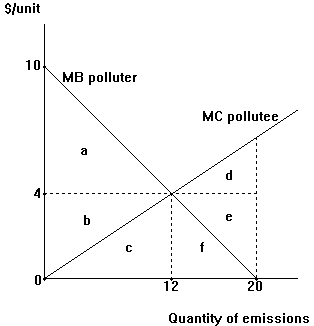MC pollutee = farm with wheat
MC' = farm with clover

III. Property
D. Conflicting property rights
1. Incompatible uses
b. In practice (cont'd.)
(2) High
transaction costs relative to legal costs favor damage remedies
(2.2) Actual or mitigated damages?
mitigated damages: damages remaining
after cost-effective steps to avoid damages
the core of the critique by Coase--these get overlooked in Pigouvian
approach
| MB polluter = train
emitting sparks MC pollutee = farm with wheat MC' = farm with clover |
 |
Advantage to actual damages: lower
information costs
but no incentive to reduce costs--why switch to
clover w/ 100% damages paid?
Advantage to mitigated damages: provides an incentive to reduce costs
Ex: Friedman -- base damages on clover, not wheat.
Ex: Spur Industries v. Del E. Webb Development
(1972)
Entitlement to shutdown or relocation costs reduces optimal location
incentives (P63)
(3) High transaction costs and legal costs favor Pigouvian approach
There is still a major role for the Pigouvian
approach.
Many of our most substantial externality problems are not litigated,
they are legislated.
Ex: court recognized this in Boomer v. Atlantic Cement
Note 1: a liability right provides an incentive to report the tort.
liability right = a Pigouvian tax +
compensation + incentive for private enforcement.
Note 2: with low transaction costs, Pigouvian approach can lead to too
much abatement, since failure to compensate leaves room for side bargains.
| Choosing rules: | Legal costs | ||
| High | Low | ||
| Transaction costs | High | Pigouvian approach | Liability right: damages |
| Low | Property right: injunction/easement | ||
2. Takings
commonly known as eminent domain
Conflicting property rights dispute now is typically between a private and public party rather 2 private parties
a. basic analysis
U.S. Constitution, 5th amendment: "nor shall private property be taken for public use, without just compensation." (CU174)
(i) "private property" = a particular piece of property owned by a particular person (CU175)
Why not include taxes as takings?
What problem would the government have then?
(ii) "taken"
Why not just make the government buy it?
Government typically does make offers first
"In general, the
government should only take private property with compensation to provide a public good
when transaction costs preclude purchasing the necessary property." (CU177)
Advantage: avoids holdout problem
the seller's version of the free rider
"a good economic argument for eminent domain. . . is that it is
necessary to prevent monopoly." (P55)
Disadvantage: risk of under-valuing property to its owner
(iii) "for public use"
Private parties face the holdout problem too.
Ex: "the developers of a new baseball stadium in Denver purchased
all the land except for the property or one 'holdout,' whom the newspaper called 'the guy
who owns first base.'" (CU177)
1994: A trust held by the
Cowperthwaite family was awarded total compensation of $ 2,375,036. The decision by
arbitrator Mitchel B. Johns, a former Denver judge, is binding and cannot be appealed.
Why not for private use too?
Risk of rent seeking
(iv) requires "just compensation"
"fair market value"
to finance just compensation requires "the government must take, without compensation, from the taxpayer." (P59)
So what is the net efficiency gain of requiring just compensation?
"[T]he requirement of compensation can be viewed
as a device to channel government finance into taxes and away from takings." (CU175)
Advantages: Government
internalizes policy costs and spreads risks (CU178)
Disadvantage: Reduces
private sector incentives for careful investment planning
Poletown Neighborhood
Council v. City of Detroit 410 Mich. 616 (1981)
What are the facts of the
case?
Illustrates taking for a debatable public purpose
Father-in-law as city attorney for Santa Fe Springs did the same for
city redevelopment but expressed discomfort about doing it
b. Regulation versus taking
Ex: Taking: government takes 10% of your property for
a drainage ditch
Regulation: Government blocks your residential development of wetlands property and your
property value falls 10%.
Pennsylvania Coal
Co. v. Mahon 260 U.S. 393 (1922) --
Justice Holmes: The general rule at least is, that while property may be regulated to a
certain extent, if regulation goes too far it will be recognized as a taking. (LEA226)
Only says that such a line might exist without saying where it goes, or
why it matters." (LEA220)
Prior, physical invasion was necessary for such a 'taking' to occur.
(LEA226)
What are the facts of the
case?
Extends takings to include regulation
Keystone
Bituminous Coal Association v. DeBenedictis 480 U.S. 470 (1987)
What are the facts of the
case?
Exempts substantial regulation from compensation requirement
present status: compensation is not paid for regulations (CU178)
regulation takings are costly to compensate because
of broad impact.
Also, gov't does not charge landowners for beneficial impacts
from regulations. (P58)
Advantage: incentive for cautious
private investments
Disadvantage: incentive for excessive government regulation (CU181)
Zoning
In theory, zoning reduces a nuisance
Zoning is not
compensated--which avoids an incentive to create nuisances. (P59)
"[I]n reality, zoning is a highly political
institution"--lots of rent seeking. (CU186)